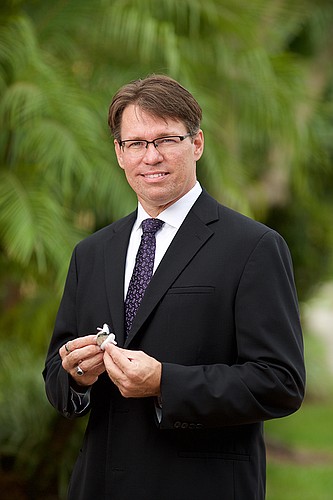- November 24, 2024
-
-
Loading

Loading

Naples-based Tamiami Angel Fund II says its nearly $1 million investment in Catalyst OrthoScience looks like a winning wager.
That conclusion comes after more than a dozen arthritic patients received a novel shoulder replacement device Catalyst OrthoScience founder Dr. Steven Goldberg devised to help them regain painless natural motion in their shoulders. The prominent Naples orthopedist began doing the surgeries in August.
“We thought this technology could be very dominating” in the orthopedic market, says Timothy Cartwright, an investment manager at Fifth Avenue Advisors and chairman of Tamiami Angel Funds.
The angel fund hopes Catalyst OrthoScience can reach a break-even point or profitability without taking on a venture fund investment, a typical second step for an early-stage company that receives angel fund backing. Avoiding that step will help ensure against dilution of Tamiami Angel Fund II's investment, Cartwright says.
The uniqueness of the Catalyst CSR Shoulder System, Catalyst OrthoScience says, is a compact design that more accurately replicates the shape of the shoulder than do other shoulder devices.
A Columbia University-trained physician and chief of the Division of Orthopedic Surgery at Physicians Regional Healthcare System in Naples, Goldberg received a $930,000 investment from Tamiami Angel Fund II in September after pitching his device to the 40-member group. Goldberg also obtained another $2.37 million from IrishAngels, a Chicago-based group in which investors are graduates, parents or faculty from the University of Notre Dame.
The combined $3.3 million marks the largest first-round raise of outside capital for a Southwest Florida company so far this year, according to data from PricewaterhouseCoopers's MoneyTree Report.
Tamiami Angel investors says Catalyst OrthoScience “stood out really well,” Cartwright says, emphasizing the fund backs only one of about every 100 products or services pitched. Already having a patent and U.S. Food and Drug Administration approval on the device was a big help because that mitigates investor risk.
“We were impressed with Dr. Goldberg,” Cartwright says.
Goldberg also boosted his cause by hiring a CEO, 27-year medical-device industry veteran Stephen Herrington. The new CEO says he signed on with Catalyst
OrthoScience after concluding Goldberg's shoulder replacement system had “significant advantages for the surgeon, patient and hospital.”
Total shoulder surgery is a difficult undertaking, but the slim, less invasive design of his company's device helps to keep much of the patient's anatomy in place, Herrington says.
“You're basically replacing the wearing surface behind the humerus and glenoid,” says Herrington. “The arthritis is typically deep in those surfaces. We replace them with highly engineered biomaterials made of advanced metals and plastics.”
Surgeons like it, he adds. “They are saying, 'Wow! This is different from anything we've seen.'”
Herrington says he'd be “very happy” with a 20% share of a $1 billion market that's growing up to 9% a year. With that kind of growth, he says, “you've got the tide working with you.”
Goldberg's 10 implants in Naples and several more in the Midwest by other surgeons have the inventor confident the years of work on the device will pay off.
“I think it is going to change people's perception” of shoulder replacement surgery, Goldberg said in an email.
“It was almost three years of recognizing the problem and creating possible concepts that might work before settling on a design,” he says. “Then it has taken another four years to develop that design to where we are now.”